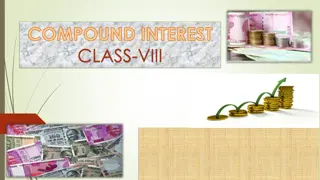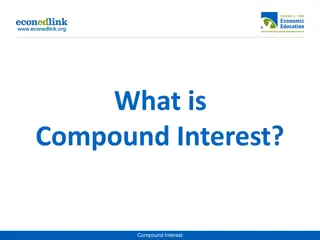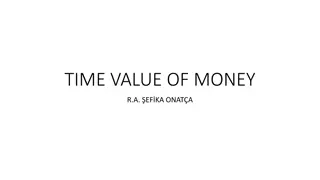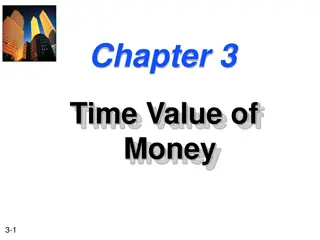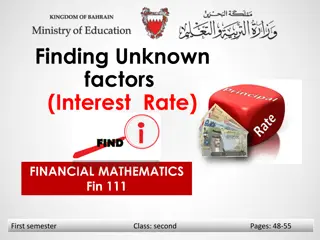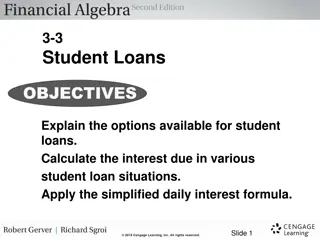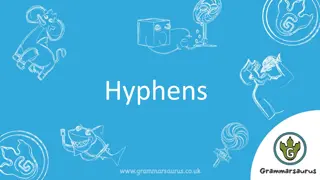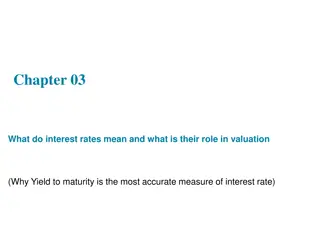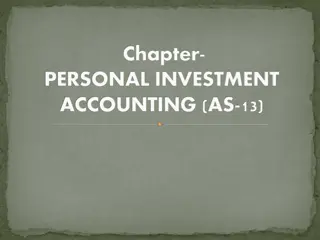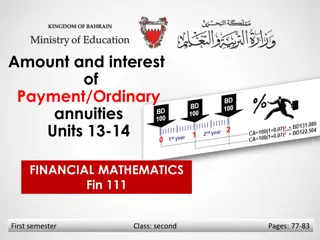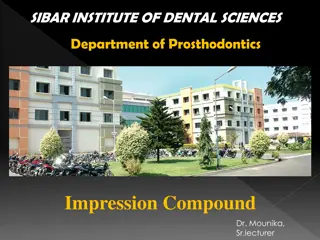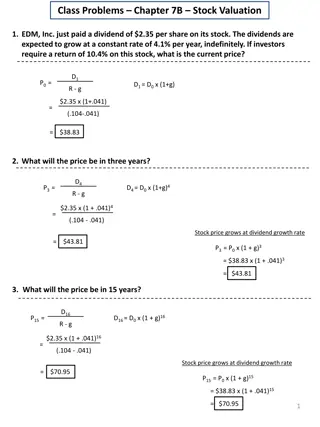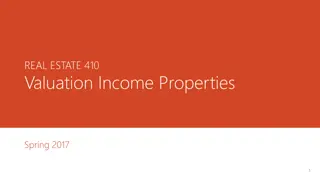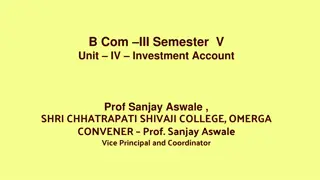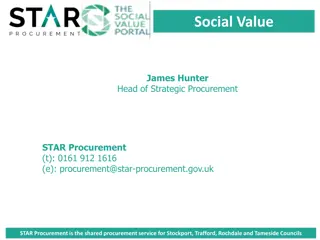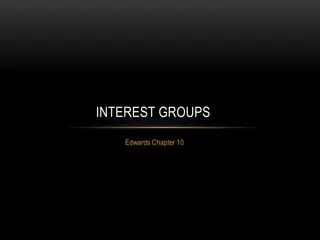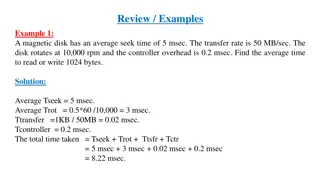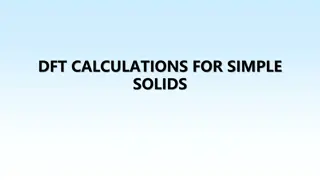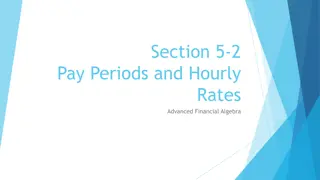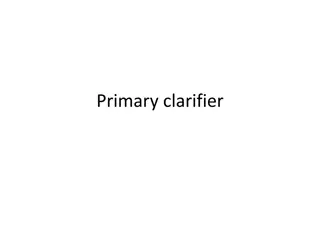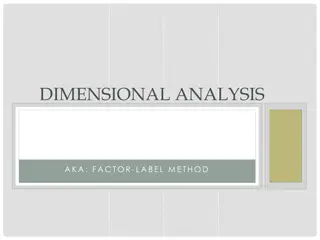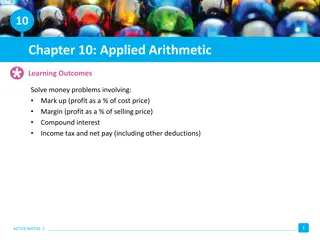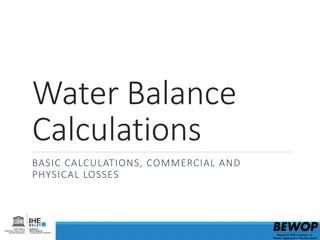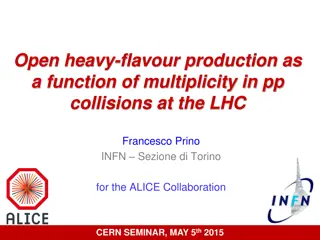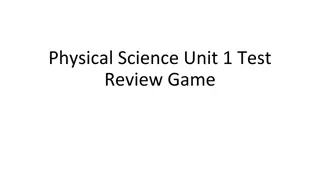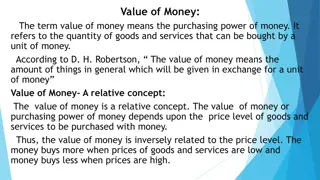Understanding Compound Interest and Future Value Calculations
Explore the concept of compound interest, its comparison with simple interest, and key formulas to calculate future values. Learn how to calculate interest rates, compounding periods, future values of investments, and present values of money. Understand the significance of periodic rates of interest versus nominal rates and get insights into solving problems related to equivalent values.
Uploaded on Jul 20, 2024 | 0 Views
Download Presentation

Please find below an Image/Link to download the presentation.
The content on the website is provided AS IS for your information and personal use only. It may not be sold, licensed, or shared on other websites without obtaining consent from the author. Download presentation by click this link. If you encounter any issues during the download, it is possible that the publisher has removed the file from their server.
E N D
Presentation Transcript
Compound Interest FV & PV Unit 9
Learning Objectives 1. Calculate interest rates and the number of compounding periods 2. Compute future (maturity) values of investments 3. Compute present values of future sums of money 4. Discount long-term promissory notes 5. Solve problems involving equivalent values
Compound Interest What is it? Interest in earlier periods earns interest in future periods Interest for a certain time period is computed using the original principal plus all the interest earned in prior periods Note that the interest for the first period is the same as computed using simple interest
Comparison Simple vs Compound Battle of Interest Principal of $10,000 invested for a term of 5 years at 10% per Annum (p.a.) Simple Interest Compound Interest Interest Calculation Interest Amount Interest Calculation Interest Amount Year Balance 10,000.00 $ 11,000.00 $ 12,000.00 $ 13,000.00 $ 14,000.00 $ 15,000.00 $ Balance 10,000.00 $ 11,000.00 $ 12,100.00 $ 13,310.00 $ 14,641.00 $ 16,105.10 $ 0 1 2 3 4 5 (0.10)(10,000) (0.10)(10,000) (0.10)(10,000) (0.10)(10,000) (0.10)(10,000) 1,000.00 $ 1,000.00 $ 1,000.00 $ 1,000.00 $ 1,000.00 $ (0.10)(10,000) (0.10)(11,000) (0.10)(12,100) (0.10)(13,310) (0.10)(14,641) 1,000.00 $ 1,100.00 $ 1,210.00 $ 1,331.00 $ 1,464.10 $ Interest Calculation: I = Prt, where t is one period (1 year) Term is the length of time of the investment
Key Formula!! To compute future value (FV) using compound interest, we use the following formula: ?? = ?? ? + ?? PV is the Principal Value i is the periodic rate of interest n is the number of compounding periods in the term Future Value using simple interest calculations uses the formula S=P(1+rt)
Periodic Rate of Interest versus Nominal Rate of Interest Periodic interest is the interest rate per period, not to be confused with the nominal annual rate of interest 4% p.a. compounded semi-annually is an example of a nominal annual rate of interest p.a indicates per annum Compounded semi-annually indicates interest is compounded twice per year (more in a bit) 2% (every six months twice per year) is the corresponding periodic rate of interest
Periodic Rate of Interest versus Nominal Rate of Interest - Notation To sum, j = nominal annual rate m = number of compounding periods per year i = periodic rate of interest So, i = ? ?
Number of Compounding Periods (n) The term of an investment or loan is the length of time money is invested or loaned in total (usually stated in years or months) The number of compounding periods is the total number of compounding periods in the term of the investment ? = ?????? ?? ????? ?? ???? x x ?
Practice For a sum of money invested at 2.4% compounded semi-annually for 3.5 years, state The nominal annual rate of interest (j) The number of compounding periods per year (m) The periodic rate of interest (i) The number of compounding periods in the term (n) The compounding factor (1+i)n The numerical value of the compounding factor
Applying the FV formula A deposit of $1,000 earns interest at 4% p.a. compounded quarterly for three years and five months. At that time, the interest rate changes to 6% p.a. compounded monthly. What is the value of the deposit two years after the change in the rate of interest?
Solution There are two major calculations, FV1 and FV2 FV1 i = 4%/4 = 1.00% (0.01) every three months n = 3*4 + 1.6666667 = 13.666667 periods FV1 = 1,000(1+0.01)13.666667 = $1145.667983 FV2 i = 6%/12 = 0.5% (0.005) every month n= 2 years x 12 = 24 periods FV2 = $1145.667983(1+0.005)24 = $1291.35
A Time Line of the Event Now 3y5m (4.416667y) 5.416667y 2y i=4%/4 = 1.00% = 0.01 n=3.416667 years x 4 times per year = 13.666667 periods (quarters) i=6%/12 =0.5%=0.005 periods n=2 years x 12 times per year = 34 periods (months) $1,000 $1145.667983 $1291.35
FV Practice Questions Q1. A debt of $8000 is payable in 7 years and 5 months. Determine the accumulated value of the debt at 10.8% p.a. compounded annually Q2. A variable rate demand loan showed an initial balance of $2,000, payments of $500 after 18 months, $400 after 30 months, and a final payment after 5 years. Interest was 5.5% compounded semi- annually for the first two years and 6.5% compounded monthly for the remaining time. What was the size of the final payment?
Present Value (PV) and Compound Discount The principal that will grow to the given amount if compounded at a given periodic rate of interest over a given number of conversion periods is the Present Value Present Value Formula: ?? ?? = 1 + ?? which can also be expressed as: ?? = ?? 1 + ? ?
Key Point!! Difference between the known future amount and the computed present value (principal) is the compound discount and represents the compound interest accumulating on the computed present value Compound Discount = FV PV
Calculator Tips Cash Flow Conventions Cash flow = cash payment Cash INFLOW : represents $$$ to us -> enter as a positive value Cash OUTFLOW: represents $$$ from us -> enter as a negative value
Calculator Tips Increasing the number of decimals in TI BAII Plus Will show how in class
Practice Questions - PV Q1. How much would you have to deposit in an account today to have $2000 in a five year term deposit at maturity if interest is 2.75% compounded semi-annually? Q2. In negotiating a contract for your business, you have to decide between receiving $65,000 now or $25,000 now and $45,000 three years from now. In terms of today s dollar, which choice is better and by how much? Money is worth 4.25% compounded annually.
Discounting Non Promissory Notes Non- -Interest Interest- -Bearing Bearing The face value of a non-interest-bearing note is also its maturity value The proceeds of a non-interest-bearing note are the present value of its face value at the date of discount face value=maturity value maturity date issue date discount date discount period
Discounting Non-Interest-Bearing Promissory Notes Find the proceeds of a non-interest bearing note for $5,000 discounted 2 years before maturity. The interest rate is 3% compounded monthly The maturity value is equal to the face value i=3%/12=0.25%=0.0025 per period (month) n=2 years x 12 times per year = 24 periods ?? = 5,000 1 + 0.0025 24= $4,709.18 (????????)
Discounting an Discounting an Interest Promissory Note Promissory Note Interest- -Bearing Bearing The proceeds of an interest-bearing note are equal to the present value (of the maturity value of the note) at the date of discount Two steps are required: 1. Determine the maturity value of the note use the note s stated interest rate and the entire length of the note 2. Determine the proceeds by discounting the maturity value find the present value using the prevailing interest rate and the time between the discount date and the maturity date
Discounting an Interest Discounting an Interest- -Bearing Promissory Note Promissory Note Bearing On April 1, 2014, a three-year promissory note for $5,000 is issued with an interest rate of 6% compounded semi-annually. The note is discounted on April 1, 2016 at 8% compounded quarterly. Find the proceeds of the note maturity value? April 1, 2017 Proceeds = discounted value? April 1, 2016 $5,000 April 1, 2014 discount period 1 year = 4 quarters
Discounting an Interest Discounting an Interest- -Bearing Promissory Note Promissory Note Bearing Maturity value i=6%/2=3%=0.03 every six months n=3 years x 2 times per year = 6 periods in the term Proceeds (Discounted Value) ?? = 5,000 1 + 0.036= $5,970.261483 i=8%/4=2%=0.02 every 3 months (quarter) n=1 year x 4 times per year = 4 periods ?? = 5,970.261483 1 + 0.02 4= $5,515.60
Practice Promissory Note Q1. Find the proceeds of a $1000, four year note bearing interest at 2% compounded quarterly, discounted two and a half years after the date of issue at 3% compounded monthly.
More Promissory Note Questions Q2. A seven year, non-interest bearing note for $10000 is discounted 3 years and 8 months before its due date at 4% compounded quarterly. Find the proceeds of the note. Q3. A $2800 promissory note issued without interest for five years on Jan 13, 2016, is discounted on June 30, 2020, at 6% compounded quarterly. Find the compound discount.
Equivalent Values Amounts of money have different values at different times (Time Value of Money) When sums of money fall due or are payable at different times, they are not directly comparable To make such sums of money comparable, a point in time (comparison/focal date) must be chosen for the comparison
Equivalent Values If the due date of the payment falls before the focal date, use the FV formula ?? = ?? ? + ?? If the due date of the payment falls after the focal date, use the PV formula ?? = ?? ? + ? ?
Calculating Equivalent Values Calculating Equivalent Values (payments) (payments) Debt payments of $500 due three months ago, $1,000 due today, and $2,000 due in fifteen months are to be combined into one payment due six months from today at 12% p.a. compounded monthly Find the size of that payment $2,000 15 months from today Equivalent Payment? 6 months from today $500 due 3 months ago $1,000 today
Calculating Equivalent Values Calculating Equivalent Values (payments) (payments) i=12%/12=1% per period (month) Equivalent Payment? 6 months from today Focal date $2,000 15 months from today $500 due 3 months ago $1,000 Today (0) E2 n=6 periods (months) ?? = 1,000 1 + 0.016= $1,061.52 n=15-6=9 periods (months) ?? = 2,000 1.01 9 = $1,828.68 E3 n=3+6=9 periods (months) ?? = 500 1 + 0.019= $546.84 E1
Calculating Equivalent Values Calculating Equivalent Values (payments) (payments) From the graphic we can see that the equivalent payment at month six is calculated to be E1+E2+E3: Summary Equivalent Payment Amount E1 E2 E3 Total $546.84 $1,61.52 $1,828.68 $3,437.04
Two or More Equivalent Replacement Payments An equation of values matching the dated values of the original scheduled payments against the dated values of the proposed replacement payments on a selected focal date should be set up (the focal date is arbitrary) Equivalent value of original payment(s) at the focal date = Equivalent value of replacement payment(s) at the focal date
Two or More Equivalent Replacement Payment Joe is due to make a payment of $2,500 now. Instead, he has negotiated to make two equal payments one year and two years from now. Determine the size of the equal payments if money is worth 7.5% compounded quarterly. The focal date can be arbitrary but it should be chosen to reduce the number and complexity of the calculation Choose today as the focal date for convenience
Two or More Equivalent Replacement Payment i=7.5%/4=1.875% per period (quarter) We call the unknown replacement payments both x as they are equivalent x 2 years $2,500 Today = now x 1 year Focal date n=1 x 4=4 periods E1 ?? = ? 1 + 0.01875 4= 0.928389? n=2 x 4 = 8 periods E2 ?? = ? 1 + 0.01875 8= 0.861904258?
Two or More Equivalent Replacement Payments From the graphic we can see that the equivalent payment at the focal date is calculated to be E1+E2=1.790292x Replacement payments E1 0.928388x E2 0.861904x Total 1.790292x 1.790292x = 2,500 x=$1,396.42 is the size of each replacement payment
Equivalent Payment Questions Q1. Scheduled payments of $800 due one year ago and $1000 due six months ago are to be replaced by a payment of $400 now, a second payment of $1000 nine months from now, and a final payment 18 months from now. What is the size of the final payment if interest is 10.8% compounded quarterly?
More Questions Q2. A loan of $15000 borrowed today is to be repaid in three equal installments due in one year, three years, and five years, respectively. What is the size of the equal installments if money is worth 6.2% compounded monthly?
More Questions Q3. A payment of $500 is due in six months. Interest is compounded quarterly at 4% the first six months and is compounded at 6% monthly thereafter. A second payment of $800 is due in 18 months. These two payments are to be replaced by a single payment nine months from now. Determine the size of the replacement payment nine months from today if the focal date is nine months from now.
Summary With compound interest, earned interest is added to the principal and thus interest is earned on interest resulting in exponential growth The Future Value (maturity value) of an investment using compound interest can be expressed by the formula FV = PV(1+i)n The Present Value (discount) of an investment using compound interest can be expressed by the formula PV = FV(1+i)-n
Summary The discounting of promissory notes involves discounting (PV) using the period from the maturity date back to the discount date There are two types of promissory notes, interest bearing and non-interest bearing The equivalent value of a series of payments can be found using the sum of FV and/or PV calculations


